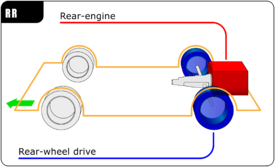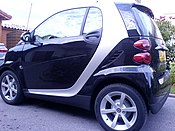Rear-engine design
In
center of gravity of the engine
itself is behind the rear axle. This is not to be confused with the center of gravity of the whole vehicle, as an imbalance of such proportions would make it impossible to keep the front wheels on the ground.

Rear-engined vehicles almost always have a rear-wheel drive
four wheel drive
. This layout has the following features:
- Packaging: since there is no need for a transmission tunnel, the floor can be flat.[1]
- Rear traction: having the engine located over the driven wheels increases downward pressure, which is helpful for grip on loose surfaces, although can be prone to oversteer.[2]
- Simplicity of manufacture: the engine is near the driven wheels, and the transmission can be merged with the differential to save space.
This layout was once popular in small, inexpensive cars and light commercial vehicles. Today most car makers have abandoned the layout although it does continue in some expensive cars,[3] like the Porsche 911. It is also used in some racing car applications,[4] low-floor buses, some Type-D school buses, and microcars such as the Smart Fortwo. Some electric cars feature both rear and front motors, to drive all four wheels.[5]
Notable rear-engined cars

- Benz Patent-Motorwagen
- BMW 600, 700, and i3
- Chevrolet Corvair[6]
- Davrian
- DMC DeLorean
- Dune buggies such as the Meyers Manx
- 133
- FMR Tg500
- Hillman Imp
- Hino Contessa
- Mercedes-Benz 130/150/170H
- Mitsubishi i and Mitsubishi i-MiEV
- NSU Prinz
- Porsche 356, 911 generations, and 959
- Puma (car manufacturer)
- SEAT 600, 850 and 133
- Simca 1000
- Smart Fortwo, Roadster and 2nd generation Smart Forfour
- Stout Scarab
- Subaru 360, Subaru R-2, 1st generation Subaru Rex
- Suzuki Fronte 360, Fronte 71 and 72, Fronte Coupé, Fronte LC20, Fronte 7-S / SS10 / SS20 and Cervo SS20 / SC100
- Tata Nano, Tata Pixel and Tata Magic Iris
- Tatra 77, 87, 97, 600, 603, 613, 700
- Model 3
- Tucker 48 'Torpedo'
- Volkswagen Type 62 and Type 82 Kubelwagen, the Kommandeurswagen and Schwimmwagen
- type 181 'Thing'
- Zaporozhetsseries.
See also
References
- ^ "1965 Chevrolet Corvair". Retrieved 16 March 2019.
- ^ "What Is Rear Engine Layout And Know How Is It Beneficial?". Retrieved 16 March 2019.
- ^ Threewitt, Cherise. "10 Affordable Rear Engine Cars". Retrieved 16 March 2019.
- ISBN 0-471-35461-9.
- ^ Adams, Eric. "The Secrets of Electric Cars and Their Motors: It's Not All About the Battery, Folks". Retrieved 16 March 2019.
- ^ Golseth, Andrew. "Why Is The Chevrolet Corvair Such An Overlooked Classic?". Retrieved 16 March 2019.
